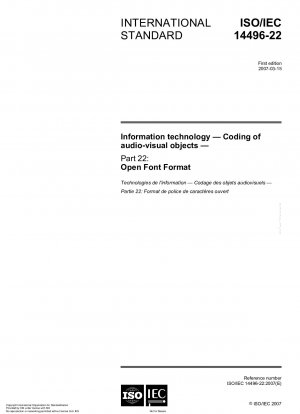ISO/IEC 14496-22:2007
Information technology - Coding of audio-visual objects - Part 22: Open Font Format
- Standard No.
- ISO/IEC 14496-22:2007
- Release Date
- 2007
- Published By
- International Organization for Standardization (ISO)
- Status
- Replace By
- ISO/IEC 14496-22:2009
- Latest
- ISO/IEC 14496-22:2019/Amd 2:2023
- Scope
- This International Standard specifies the Open Font Format (OFF) specification, the TrueType?1) and Compact Font Format (CFF) outline formats, and the TrueType hinting language. Many references to both TrueType and PostScript?2) exist throughout this document, as Open Font Format fonts combine the two technologies. NOTE This International Standard is based on the OpenType?3) version 1.4 font format specification, and is technically equivalent to that specification. Multimedia applications require a broad range of media-related standards. In addition to the typical audio and video applications, multimedia presentations include scalable 2D graphics and text supporting all languages of the world. Faithful reproduction of scalable multimedia content requires additional components including scalable font technology. The Open Font Format is an extension of the TrueType font format, adding support for PostScript font data. OFF fonts and the operating system services which support OFF fonts provide users with a simple way to install and use fonts, whether the fonts contain TrueType outlines or CFF (PostScript) outlines. The Open Font Format addresses the following goals: - broader multi-platform support; - excellent support for international character sets; - excellent protection for font data; - smaller file sizes to make font distribution more efficient; - excellent support for advanced typographic control. PostScript data included in OFF fonts may be directly rasterized or converted to the TrueType outline format for rendering, depending on which rasterizers have been installed in the host operating system. But the user model is the same: OFF fonts just work. Users will not need to be aware of the type of outline data in OFF fonts. And font creators can use whichever outline format they feel provides the best set of features for their work, without worrying about limiting a font's usability. OFF fonts can include the OFF Layout tables, which allow font creators to design broader international and high-end typographic fonts. The OFF Layout tables contain information on glyph substitution, glyph positioning, justification and baseline positioning, enabling text-processing applications to improve text layout. As with TrueType fonts, OFF fonts allow the handling of large glyph sets using Unicode encoding. Such encoding allows broad international support, as well as support for typographic glyph variants. Additionally, OFF fonts may contain digital signatures, which allow operating systems and browsing applications to identify the source and integrity of font files, including embedded font files obtained in web documents, before using them. Also, font developers can encode embedding restrictions in OFF fonts which cannot be altered in a font signed by the developer.
ISO/IEC 14496-22:2007 history
- 2023 ISO/IEC 14496-22:2019/Amd 2:2023 Information technology — Coding of audio-visual objects — Part 22: Open Font Format — Amendment 2: Extending colour font functionality and other updates
- 2020 ISO/IEC 14496-22:2019/Amd 1:2020 Information technology — Coding of audio-visual objects — Part 22: Open Font Format — Amendment 1: Color font technology and other updates
- 2019 ISO/IEC 14496-22:2019 Information technology — Coding of audio-visual objects — Part 22: Open Font Format
- 2017 ISO/IEC 14496-22:2015/Amd 2:2017 Amendment 2 - Information technology - Coding of audio-visual objects - Part 22: Open Font Format - Updated text layout features and implementations
- 2017 ISO/IEC 14496-22:2015/Amd 1:2017 Information technology — Coding of audio-visual objects — Part 22: Open Font Format — Amendment 1: Updates for font collections functionality
- 2015 ISO/IEC 14496-22:2015 Information technology - Coding of audio-visual objects - Part 22: Open Font Format
- 2012 ISO/IEC 14496-22:2009/Amd 2:2012 Information technology - Coding of audio-visual objects - Part 22: Open Font Format - Amendment 2: Additional script and language tags
- 2010 ISO/IEC 14496-22:2009/Cor 1:2010 Information technology — Coding of audio-visual objects — Part 22: Open Font Format — Technical Corrigendum 1
- 2009 ISO/IEC 14496-22:2009 Information technology - Coding of audio-visual objects - Part 22: Open Font Format
- 2007 ISO/IEC 14496-22:2007 Information technology - Coding of audio-visual objects - Part 22: Open Font Format
